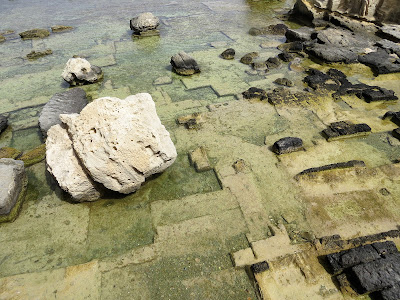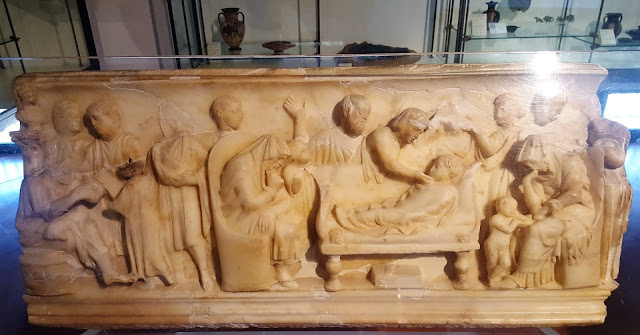 |
| Marsala wine at a sidewalk table in Marsala. One of the city gates is in the distance. |
You've heard of Marsala. You've probably drank it or used it in cooking or at least had restaurant dishes that use it: chicken Marsala, shrimp Marsala, etc. Marsala, the westernmost town on the island of Sicily, is where the popular fortified wine originated. Marsala tastings and winery visits are among the town's attractions, though I have the impression that not many Americans or other international travelers visit here.
Of course, as with almost every bit of land in this part of the world, there is history. Marsala was once under the control of the North African Phoenician city-state of Carthage, which fought Greece and Rome for control of Sicily in the Punic Wars. Though that all ended a couple of millennia ago, it is recalled at a small museum on the nearby resort island of Favignana. It contains bronze rams that were mounted on Roman and Carthaginian ships in 241 B.C.E. when an important naval battle was fought in nearby waters, the Battle of the Egudi Islands. Two hundred Roman ships, powered by oarsmen, defeated four hundred Carthaginian ships in the last naval battle of the First Punic War. The rams were about all that remained when ships sunk in the battle were discovered in the late 20th century. The museum is housed in a former tuna-processing factory, which also has a museum on the history of tuna fishing and processing. You can easily walk to it from the ferry landing, though signs pointing toward it can send you astray.
We visited Favignana as a day trip, taking a ferry from Marsala's small harbor, but we met a couple from Palermo who frequently make the drive to Marsala, ignore the town, and spend long weekends entirely on Favignana. Beaches -- sandy or rocky, your choice -- and loads of inns, restaurants and shops make this a popular getaway for Sicilians.
Other adventures out of Marsala included visiting Salene della Laguna, a traditional sea salt harvesting operation north of town. We walked among the pools where evaporation of sea water was leaving behind salt. We didn't see the seafoam process, in which, on rare windless days, foam forms on some of the pools and is scooped off and dried, producing a rare and expensive fine white salt, not the large grains of salt that often go into grinders. We bought several jars of the "soffi di sale" as gifts and for our own use at home.
After a morning visit to the salt works, we drove about an hour to visit the Gorghi Tondi winery east of town. We're not particular fans of Marsala wine, so we went to one winery that doesn't make any fortified wine, though Gorghi Tondi does make a sweet dessert wine from the grillo grape, which figures prominently in making Marsala. The sweetness comes from late harvest and botrytis cinerea, the "noble rot" that is used in making Sauternes in France. The tasting here was well worth the drive, and we made it home with a half-case of wine embedded in our luggage, including three bottles of the dessert wine.
 |
| Lemon-based drinks are sold on the piazza outside the Duomo in Marsala. |
 |
| Jane and I are reflected in a mirrored ceiling at a wine bar in Marsala. Those little bowls all held different snacks. |
 |
| A wine tasting in the courtyard of what was once a ducal palace. |
 |
| A G&T and an Aperol spritz at another sidewalk cafe on a sidestreet in Marsala. |
 |
| A food truck keeps visitors well fed on the island of Favignana. |
 |
| Anglers fish from the rocks off a seaside promenade on Favignana. |
 |
| Steps from a seaside sidewalk allow people to venture out onto the rocks and to swim in the water beyond them. This area seems to once have been a quarry. |
 |
| Did you notice these carvings in the preceding photo? My guess is that they were carved by quarry workers in rock that was too soft to be harvested. |
 |
| The straight lines in the stone are signs that this was once a quarry. |
 |
| A hilltop fortress looks down on Favignana's small but busy harbor. |
 |
| Windmills once provided power to pump sea water from one pool to another at Saline della Laguna near Marsala. |
 |
| The trees in the distance are on an island that protects Saline della Laguna from storm-driven waves that could interfer with its age-old system of drying seawater to collect salt. |








































